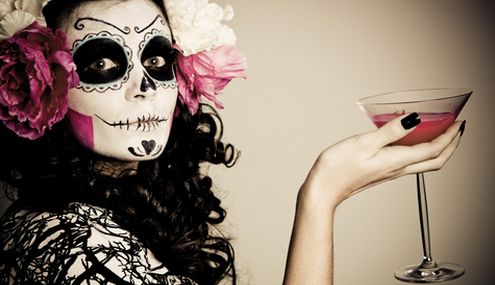If James Bond careening through Mexico City in Spectre tells us anything, it’s that the city is bursting with life on Día de los Muertos, the day it celebrates its dead. In macabre costumes and skeletal faces, painted and embellished with glitter and beads, locals take to dancing in high-spirited street festivals that pulsate with more gusto than Mardi Gras. And what’s not to celebrate? On October 31, life and love triumph over death, the gates of heaven are thrown open, and the dead are allowed to live again.
In a blending of Aztec and Spanish Catholic beliefs, the Day of the Dead sees homes spiffed up and an ofrenda or altar made and decorated with candles, flowers, fruit, and traditional foods. Hot cocoa, sugar skulls, and toys await the spirits of children, little treats after their long journey from the spirit world.

Mexican Day of the Dead
At night, musicians wander the cemeteries, serenading families that are cleaning tombs and picnicking while they await the arrival of their dearly departed. The first to arrive each year are the angelitos, the deceased children, who are reunited with their parents for 24 hours. Two days later, the spirits of the adults arrive to enjoy offerings of mescal and cigarettes and, in turn, bestow on their loved ones protection, blessings, and good luck for the coming year.
While the living and dead members of these Central American families are eating, drinking, and being merrily reunited, other parts of the world are subjected to a night of scary monsters and malevolent ghosts. October 31 is Halloween, a tradition with roots in the Celtic Samhain, the day the harvest season ended and winter began. It was a transition that, for the imaginative Celt, opened a portal between worlds, and prompted them to light bonfires and don devilish garb to ward off nefarious phantoms.
These days, Halloween is more of a children’s holiday, but it still piques people’s obsession with the macabre and fosters an excess of dark and mysterious pastimes, including rolling out the Ouija board, dressing up as witches, disemboweling pumpkins, watching horror films, and touring local cemeteries. After all, who doesn’t love a good midnight scare in a graveyard?
But these ghoulish midnight travels are vastly different from the graveyard festivities in Mexico. Sitting on graves, dressed and painted like they’ve been six-feet under, and welcoming spirits with open arms is a far cry from the fear of the supernatural at the heart of the Halloween world. This should come as no surprise in a Western society so uncomfortable with death that nursing homes, hospices, and a $20.7 billion funeral industry has grown up to handle wakes and bury the dead.
Yet, the horror story remains a Halloween staple. We may squirm at the prospect of death, but we are fascinated by its grotesquery. Theories for this abound, from finding comfort in creating distance between us and violent acts we know aren’t real, to purging negative emotions or relieving pent-up aggression, or indeed feeling vindicated that in Act III good triumphed and evil was vanquished.
For those not inclined toward celebrating the Day of the Dead, the notion of spirits walking the earth is met with fear and superstition. In my work, I’ve met many people who sensed a presence but were terrified that something from The Sixth Sense lurked in the dark corners of the living room. Some burned sage in a blind panic that something wicked their way comes, and others rushed to a priest to escape the fate of Linda Blair.
We tend to perceive the continued existence of the soul or consciousness as a perversion of the natural order: if something dead has arisen or if something is here and not in heaven, then something is very wrong with the world.
Given the American discomfort with death, it is ironic that Spiritualism emerged out of the New York Protestant community in the mid-1800s, before the notion of communicating with the dead was considered the pathway to demonic possession or insane delusion. Espousing the belief that death is not the end and that communication with the spirits of the deceased is possible, Spiritualism swept through the Capitol and administrations from Lincoln to Coolidge. It influenced men of letters and men of science, such as evolutionist Alfred Russel Wallace, Thomas Edison, and Carl Jung, before being destroyed in a maelstrom of opportunists, frauds, and parlor tricksters.
With it went all hope of mainstream acceptance of the survival of consciousness. Discussion became derision, and open-minded scientific study became tantamount to career suicide. Nevertheless, scientists such as Dr. Raymond Moody (1975) and Dr. Eben Alexander (2012) have since provided compelling evidence for survival of consciousness through near death experiences. Dr. Ian Stevenson (1980) produced persuasive case studies on reincarnation, while Bill and Judy Guggenheim (1997) and Dr. Lou LaGrand (2008) compiled an extensive collection of accounts of people experiencing after death communication with loved ones.
In 1999, The Rev. Gino Concetti, chief theological commentator for the Vatican newspaper, went so far as to say that “communication is possible between those who live on this earth and those who live in a state of eternal repose.” After all, the communion (and communication) of saints is a central tenet of Catholicism.
Nevertheless, in our scientific reductionist culture, which the Dalai Lama says perceives absence of evidence as evidence of absence, achieving widespread acceptance of survival would take a miracle. But voices are increasingly making the case for consciousness not being an emergent property of the brain and thus not ceasing to exist when the brain dies.
Perhaps some day, our consciousness will expand beyond what we think we know, and we will realize that sensing the spirits of the dearly departed is a natural state of being, both here and in the hereafter. Perhaps, these visits will be accepted as comforting as we shift from the assumption that something is perverted (either with the world or our sanity) to an acceptance that our loved ones are alive in spirit and have dropped in to say, “I’m here, and I love you.”
Ultimately, the message of the ancients, of religions, and increasingly of men of science is one of hope––the hope that neither we nor love ever die and that we continue to have a relationship with those who have passed from this world. In this, we can transcend our smallness and see our connection to each other, to all things, and to something far greater than ourselves.
In the meantime, let us paint our faces and dance in the streets. Let us welcome the living and the dead with open arms and open hearts, and let us celebrate, at least for one day, the triumph of life over death.
